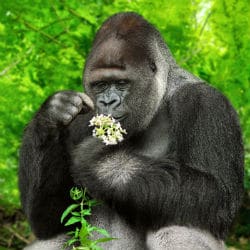News
We bring you the latest from around the World in wildlife and conservation news.
Insane Rhino Conservation Idea Might Just Work
It might sound absolutely insane given the long history Australia has had with introducing invasive species, but conservationists are seriously considering introducing rhinos now. Many people make think that idea is completely potty but all five species of rhinos in the world across Africa and Asia are increasingly under attack from habitat destruction and poaching. Rhinos are a species that used to dominate the planet but are now one of the most endangered animals on Earth.
Rescued Orangutans Released Back Into The Wild
A pair of orangutans, mother and son, were recently released back into their original habitat after having undergone an intense period of rehabilitation. The International Animal Rescue in partnership with the West Borneo Forestry Department returned the mother and son back to the wild after a period of three years. The mother whose name is Maili had been at the Indonesian rehab centre since 2015 and her son was obviously born in captivity.
Tourists Banned From Nature Park After Hurling Stones At A Panda
A number of tourists who visited a nature reserve in China threw stones at a panda in an attempt to get the bear to move have been blacklisted as a result. The panda was lying motionless beneath a tree where it had been resting in the panda enclosure of the Foping National Nature Reserve in Hanzhong North-East China. A group of approximately 20 individuals got together and began to shout at the bear and when it did not respond, one man began hurling stones at the animal.
Unusual Leopard Mating Behaviour Spotted At Game Reserve In South Africa
Leopards are solitary animals and are not known to share things with other members of their species, whether that be territory, food or a mate. Therefore, experts were extremely surprised to learn that South African park guides had captured footage of a male leopard mating with two females. Experts says they have seen two males attempting to mate with a female in heat but have never seen a situation where the roles were reversed.
Wild Mountain Gorilla Population On The Rise
There is some good news coming out of the mountains of Virunga National Park in the Democratic Republic of Congo. The population of gorillas rose from 480 in 2010 to 604 in 2016. When you add that population to the couple hundred other apes that live in scattered habitats to the south, it is estimated… View Article
Snow Leopard Cub Born With Defects Receiving Treatment At Sacramento Zoo
An extremely cute snow leopard cub that was born recently with splayed legs is undertaking intense physical therapy so the little fella is able to learn to walk. The cub was born with a number of defects including ones which affected his eyes and chest as well as an obvious case of splayed rear legs. The disease which is known as swimmers syndrome and affects both cats and dogs means that the cub has problems with mobility. As a result the Sacramento Zoo where the cub was born, is providing therapy to correct the defect.
Last Polar Bear In South Korea To Be Moved To UK
South Korea’s last polar bear will be sent to the United Kingdom so that he no longer has to contend with the stifling humid summers of the Asia Pacific and can live his life in more appropriate surroundings his keepers say. Tongki is a 23-year-old male polar bear who takes his name from a 1980’s Japanese cartoon character currently lives in a 3,500 square foot enclosure at the Everland theme park on the outskirts of Seoul. He was born in captivity and is the only bear at the zoo after another bear died three years ago.
More Tigers Owned As Pets In The United States Than In The Wild
Conservation agency Smithsonian estimates that there may be thousands more captive tigers in the United States alone than anywhere in the wild. Estimates of the US captive tiger population range from between 5,000 to 7,000. In contrast, the population of wild tigers is just 3,900 says WWF. Just how things got so bad is difficult to explain and arriving at an estimate of the pet tiger population in the United States is difficult because so many owners hide them.







